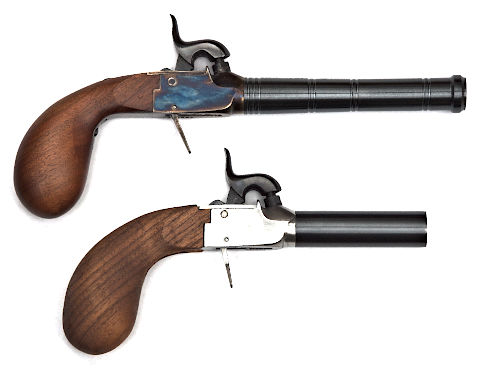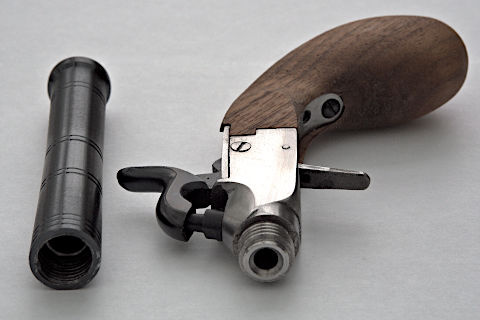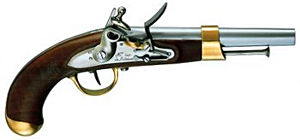
The Liegi Derringer
An Experiment
Legal notice:
To my knowledge, the Liegi Derringer has been designed to shoot round balls of soft lead. Since heavier long
projectiles generally produce a higher peak pressure and I have no information about the safety margin of this gun,
I do not encourage anybody to repeat my experiments. The following is for the purpose of information only, and
I do not assume liability for any damage caused by such experiments.
The Liegi Derringer is a breech-loading black-powder pocket pistol with a screw-off barrel. It is available with a short .44 cal barrel (total length: 60 mm / 2.4 in) or a longer .36 cal barrel (100 mm / 4 in). Both have the same internal screw thread at the breech and are interchangeable (the powder chambers are identical).

|
Liegi Derringers
The next picture shows the .36 cal version with the barrel screwed off. The caplock, a box lock in this case, and the open powder chamber can be seen on the right. Similar pocket pistols were already in use during the flintlock era.

|
Liegi Derringer with Detached .36 Cal Barrel
The loading procedure is very simple. Unscrew the barrel, hold the grip so that the powder
chamber points vertically upwards, and fill the powder to the inner (smaller) rim. Put a
round ball (no patch!) on top of the powder charge and screw the barrel back on. Pull the
hammer back to the half-cock position and put a percussion cap on the nipple. Finished!
What is this gun good for? It is definitely not a target pistol. It has no sights and the
trigger pull is rather heavy. You can't even aim over the barrel because the line of sight
is obscured by the hammer. Moreover, this light pistol tends to shoot very high because of
the recoil. Even for self defense in close-combat situations, it is of limited value because
the stopping power is insufficient although a well-placed hit can be deadly. Lore from the
Wild West says that gamblers used pistols like these to settle disputes across the card table.
Nevertheless, such a gun is nice to have, and playing around and plinking with it is just fun.
Considering the short barrel and the tiny 9-grain charge that fits in the powder chamber,
the .44 cal version is quite strong. I use a .455 cal round ball and Swiss Powder #1
(4FG). With this load, the bullet penetrates a 25 mm (1 in) pine board. In comparison, a .375 cal
round ball fired from the .36 caliber barrel with the same powder charge penetrates a 30 mm (1.2
in) pine board.
For quite a while I had been musing about how to improve the ballistic performance of the .36 cal
version by using heavier long projectiles, and I finally came up with the idea of using 9 mm or .357
Magnum bullets. Unfortunately, the diameter of these is a little too small and the projectile does
not engage the rifling. Being a re-loader, I happened to have a box of 127-grain non-jacketed
hollow-point lead projectiles* around. Their weight (127 grains) is about the same as that
of a .44 cal round ball. When these bullets are compressed along their longitudinal axis, they will
expand radially and a sufficiently tight fit in the barrel can thus be achieved. The next photo
shows the result of compressing the bullet in a machine vise. I found the fit to be perfect when
the length of this bullet is reduced from 14.7 mm to 12.7 mm. Other bullets may require a different
degree of compression which has to be found by experiment. The bullet must not be compressed more
than necessary. Otherwise, screwing the barrel back on will be a strenuous job. In any case, a vise
with polished jaws has to be used to obtain a smooth surface at both ends. A welcome side effect of
compression is the formation of a narrow rim at the base of the bullet which acts as a gas seal.
Of course, this is not a precision bullet, but we should keep in mind that we are not talking
about a precision pistol here either.
*These lead bullets (HP .357 127 gr HS) are manufactured by Haendler & Natermann, Germany. They are not only copper-plated but also have a thin coating of plastic which acts as a lubricant.

|
9 mm / .357 Magnum Lead Bullet, Original and Compressed
The loading procedure is basically the same as for round balls. After filling the powder, place the base of the
bullet on the edge of the powder chamber. As the barrel is screwed on, the bullet is forced into the breech opening
of the latter and engages the rifling. Since the bullet tends to fall off during the procedure, I have gotten into
the habit of loading the gun in two steps. I first insert the bullet into the breech and screw the barrel on which
sets the bullet correctly. Then I unscrew the barrel again, fill the powder chamber, and screw the barrel back on
once more. Due to the flat bottom of the bullet, the powder chamber can be filled up to the outer rim and now holds
about 10 grains of black powder.
During the first experiments, I took several precautions to protect myself from flying fragments in case of
a barrel burst. For this purpose, I secured the barrel between two wood boards in a vise and used a cord to pull
the trigger while taking shelter behind a wall. Only after a number of "proofing shots" and a thorough
inspection of the gun, I felt safe enough to use it in the normal way.
I was quite impressed with the results of the first (admittedly primitive) ballistic tests. With a charge of 10
grains of a 50:50 blend of 3FG and Swiss Powder #1 (pure SP #1 might be too fast for a long projectile), the gun
not only produced a hefty recoil but the bullet penetrated a 40 mm (~1.6 in) pine board and got stuck 7 mm deep
in a second board which I had placed behind the first one for safety reasons. 47 mm (1.8 in) is nothing to sneeze
at, and you don't want to get hit by a load like that. I estimate the muzzle velocity to be somewhere between 150
m/s and 200 m/s which is typical for many black-powder revolvers.
When I dug the bullet out of the second board I found it only slightly deformed which indicates that it is not made
of soft lead but of a somewhat harder lead alloy. This might contribute to the surprising penetration power. The rear
part of the bullet showed imprints of the rifling along its circumference which is exactly what I wanted.

